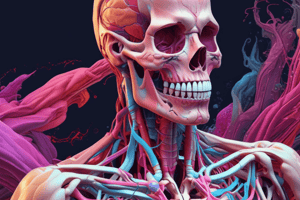Podcast
Questions and Answers
What does macroscopic anatomy primarily focus on?
What does macroscopic anatomy primarily focus on?
- Analyzing the functions of whole organ systems
- Exploring body structures visible with the naked eye (correct)
- Investigating cellular and tissue structures
- Examining the interrelationships of structures within a specific body region
Which type of anatomy uses microscopes to investigate cellular and tissue structures?
Which type of anatomy uses microscopes to investigate cellular and tissue structures?
- Microscopic anatomy (correct)
- Macroscopic anatomy
- Regional anatomy
- Systemic anatomy
What is the focus of systemic anatomy?
What is the focus of systemic anatomy?
- Examining the interrelationships of structures within a specific body region
- Analyzing the functions of whole organ systems (correct)
- Exploring body structures visible with the naked eye
- Investigating cellular and tissue structures
Which organ system includes the lungs, airways, and other structures involved in breathing?
Which organ system includes the lungs, airways, and other structures involved in breathing?
What are the main components of the nervous system?
What are the main components of the nervous system?
Which body system involves the heart, blood vessels, and blood?
Which body system involves the heart, blood vessels, and blood?
What diagnostic techniques are minimally invasive for examining the brain?
What diagnostic techniques are minimally invasive for examining the brain?
Why is regional anatomy important in studying human structure?
Why is regional anatomy important in studying human structure?
Which aspect of anatomy examines the body's organization and functioning by region?
Which aspect of anatomy examines the body's organization and functioning by region?
What does systemic anatomy provide a comprehensive view of?
What does systemic anatomy provide a comprehensive view of?
Flashcards are hidden until you start studying
Study Notes
Anatomy
Introduction
Anatomy is the scientific study of the structure of living organisms, particularly humans. It involves understanding the arrangement of body structures and their functions. The field of anatomy is broadly classified into:
- Macroscopic anatomy: Also known as gross anatomy, it explores body structures visible with the naked eye.
- Microscopic anatomy: Using microscopes, it investigates cellular and tissue structures.
- Regional anatomy: Examines the interrelationships of structures within a specific body region, such as the abdomen.
- Systemic anatomy: Focuses on the anatomy of different organ systems, like the muscular system.
Human Anatomy
The study of human anatomy has evolved over time. It can be traced back to ancient Egypt, but the modern scientific discipline developed gradually, influenced by concepts established during the time of Greek physician Galen. One of the most complex organs in the human body is the brain, which requires minimally invasive techniques for examination, such as electroencephalogram (EEG), magnetoencephalography (MEG), and functional magnetic resonance imaging (fMRI).
Systemic Anatomy
Systemic anatomy examines the various functions of whole organ systems. For instance:
- The respiratory system includes the lungs, airways, and other structures involved in breathing.
- The digestive system encompasses the gastrointestinal tract and accessory organs responsible for food processing.
- The nervous system consists of the brain, spinal cord, and nerves that transmit signals between cells throughout the body.
- The circulatory system involves the heart, blood vessels, and blood, facilitating the transport of nutrients, oxygen, and waste products.
Understanding these organ systems from a systemic perspective offers valuable insights into their unique physiological roles and interactions. However, it may not provide a complete picture of how they function together in the context of the entire body. This is where regional anatomy comes into play.
Regional Anatomy
Regional anatomy organizes the body into defined regions, allowing researchers to study the interconnections among all structures within that area. These regions include the upper limb, lower limb, trunk and back, thorax, abdomen and pelvis, head and neck, and neuroanatomy. By examining each region separately, one can appreciate the complexity of the human body's organization and functioning.
In summary, both macroscopic and microscopic anatomies are essential components of understanding human structure, while gross anatomy encompasses surface anatomy, systemic anatomy, and regional anatomy, providing a comprehensive view of our bodies.
Studying That Suits You
Use AI to generate personalized quizzes and flashcards to suit your learning preferences.





